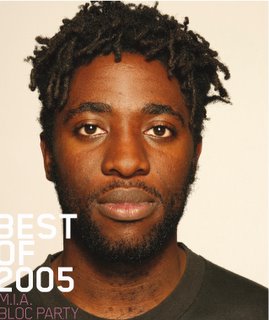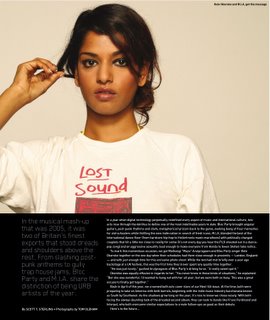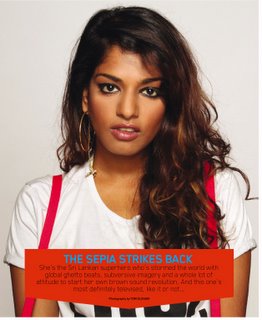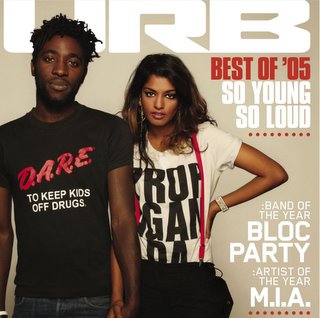
Danger Mouse’s sprawling loft ensconced deep in downtown Los Angeles is hardly the kind of crib that’s expected of the modern music-production wunderkind. Instead of housing an ostentatious display of production gadgetry and whiz-bang technophile toys, it’s the sort of open, generous space that’s more post-collegiate crash pad, a spot that most 20-something Angelenos would kill for, the only sign of excess being a gorgeous full-size jukebox that’s currently cranking out classic progressive rock.
“When it first came available, the landlord was like, ‘Oh, you’ll want it for sure,’” recalls Brian Burton, Danger Mouse’s genteel alter ego with a big grin forming underneath a formidable kinky afro that’s somewhere between Einstein and Roots drummer Amir “Questlove” Thompson. “As soon as I saw the place, I could understand why he was so confident.”
Most are already familiar with Danger Mouse as the mastermind behind 2004’s inspired blend of the Beatles’ White Album with Jay-Z’s The Black Album, appropriately titled The Grey Album. It was the kind of eureka moment that won not only a landslide of critical accolades and attention but also jump-started the “mash-up” trend that rages on to this very day.
But it’s his second act, producing Demon Days (Virgin), the sophomore full-length from animated band the Gorillaz, with Blur front man Damon Albarn, that’s exceeded all expectations, crushing any speculation that Burton was a one-trick pony in the process. The album opened at No. 6 on the U.S. Billboard charts, debuting top 5 in countries from Argentina to Denmark to Japan. It also spawned the De La Soul–inflected hit “Feel Good Inc.,” now ubiquitous thanks to the animation of band co-creator Jamie Hewlett (Tank Girl) and the Apple TV campaign. The album is a dense, genre-defying amalgamation of the past 30 years in international beat culture — and among the best releases of 2005. Encapsulating Burton and Albarn’s kaleidoscopic palette of influences (from post-punk and dub to hip-hop and indie rock) and featuring an inspired cast of characters, Demon Days plays like the Clash’s Sandinista! for the iPod generation.
Expanding his sonic universe, Burton has since teamed with metal-faced underground rap legend MF Doom, creating DangerDoom and the album The Mouse & The Mask (Epitaph), a hip-hop polyglot made in collaboration with the Cartoon Network’s progressive Adult Swim team, with the animated members of the Aqua Teen Hunger Force like Meatwad and Master Shake rocking the mic alongside Doom and guests Ghostface Killa. Space Ghost even shows up to drop a particularly blistering battle rap. The remarkable results rank among the most fun and creative hip-hop concept albums since De La Soul Is Dead.
Just days before he was scheduled to leave for Manchester, England, to take in two of the five wildly successful live presentations of Demon Days at the Opera House (complete with choirs and guest vocalists ranging from Shaun Ryder to Dennis Hopper), Burton is affable and relaxed while looking back at this year of living dangerously.
He plays me a batch of songs from various projects he has on deck for 2006, like Gnarles Barkley (including an awesome new wave cover song — I’m sworn to secrecy) and an enviable lineup of delightfully unexpected collaborators I can’t mention (yet) but who are sure to throw the music world for a serious loop when they arrive. The sounds cover an even wider range of Burton’s countless influences, and are refreshingly free of expected beat clichés. This time next year, expect a lazy (or astute — you decide) journalist to dub Danger Mouse the black Jon Brion. Oh wait...
L.A. WEEKLY: What was happening as 2005 began?
BRIAN BURTON: The Gorillaz album was basically finished, and I was still working on the DangerDoom record. I’d just started vocal demos for the Gnarles Barkley project [a collaboration with Shortlist-nominated rapper Cee-Lo Green]. I had no idea that the Gorillaz album was going to take off the way it did. These are all projects that had been in some working order for a couple of years.
LA: You really didn’t think Demon Days was going to be a hit?
It was weird, because I thought it was this really out-there record. I didn’t think that many people were going to get it. Given the way radio formats are set up in the States, I didn’t see any one song that could really fit in anywhere, and that always hurts a major label release. But that’s without taking into account the various X factors, like videos and Internet. I’m happy and surprised that so many people are into it.
LA: The momentum the iPod commercial gave “Feel Good Inc.” must’ve helped too.
Absolutely. I don’t know much about how major labels work, but back when the album was first coming out in May, they were telling us that “Feel Good Inc.” wasn’t going to peak until August. We were like, what? The iPod commercial had already been out for a month. To me, it was already done. But there is a lot more to Demon Days. We spent a lot of time and crammed so much into it.
LA: I think that’s the strength of the album. The darker, dub parts are as good as the pop songs.
The best thing with Damon [Albarn] is he finds a way to channel his influences into himself, and it works. It’s not forced — he waits for it to come. I was there to help him do that in whatever was the best and most natural way possible. So when you hear songs like “Kids With Guns” and “Last Living Souls,” that’s really him — it’s not him trying to do a style. He has a great melodic sense.
LA: What was it like working with him?
We talked a lot. We never had any arguments. We even have that finish-each-other’s-sentences thing happening. There are a lot of the same influences between us, like Ennio Morricone and psychedelic pop-rock, but he has 10 years on me, so I have some catching up to do. Where he can school me on new wave and punk of the late ’70s/early ’80s, I can school him on a lot of hip-hop. We’re very competitive and pushed each other.
LA: Why aren’t you participating in the live Gorillaz shows in Manchester?
I’m not a live musician. I play stuff, and I’m getting better at certain things, but not on the level of performing in front of people.
LA: Do you ever see that happening?
I think so. I’m not made for the stage, but I do like it when I’m done. The whole process of waiting to get onstage is not my forte. I’m a nervous wreck.
LA: What about the DJ thing?
Being a DJ for me has always been more [about] a party, fun atmosphere, where I’m just playing records and not really in the room. I’m there, but I’m not the focal point. Being a featured DJ detracts from it for me. I don’t want people to just stand there and look at me — I want them to get drunk, have fun and get laid.
(Originally published by the LA Weekly)








